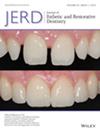Cone beam computed tomography assessment of maxillary anterior teeth cervix dimensions in healthy adults for optimal anatomic healing abutments
Abstract
Objectives
The abutments produced with circular symmetry failed to accurately replicate the natural teeth's cervical shapes. The purpose of this study was to measure cervical cross-sections of maxillary anterior teeth using cone beam computed tomography (CBCT) images to design anatomic healing abutments.
Materials and Methods
CBCT data of 61 patients were analyzed using Ez3D Plus software. Measurements were taken at the cemento-enamel junction (CEJ) and 1 mm coronal to CEJ for maxillary central incisors, lateral incisors, and canines. Various parameters, including area, perimeter, and eight line segments in the distal (a), disto-palatal (b), palatal (c), mesio-palatal (d), mesial (e), mesio-labial (f), labial (g), and disto-labial (h) directions, were used to describe dental neck contours. The ratios (f/b and h/d) were analyzed, and differences based on sex and dental arch morphology were explored.
Results
Significant differences were found in area and perimeter between males and females, but not in f/b and h/d ratios. Differences in the f/b ratio were observed among dental arch morphologies for maxillary central incisors, lateral incisors, and canines.
Conclusions
CBCT measurements of cervical cross-sections provide more accurate data for designing anatomic healing abutments. The fabrication of anatomical healing abutments needs to consider the influence of gender on cervical size and to explore the potential effect of arch shape on cervical morphology.
Clinical Significance
The novel method provides detailed measurements for the description of dental cervical contours for patients with bilateral homonymous teeth missing. The measurements of this study could be utilized to design more accurate anatomic healing abutments to create desired morphology of peri-implant soft tissue.

 求助内容:
求助内容: 应助结果提醒方式:
应助结果提醒方式:


